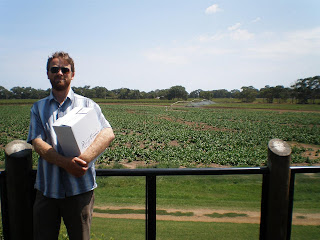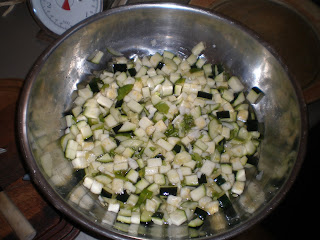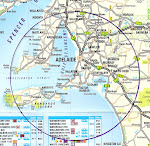I have been corresponding with Mr Laucke regarding his flour products, and he has kindly agreed to allow me to publish his answers to my questions on my Blog.
Hi There Mark,
My family have taken on the challenge of sourcing all of our food from
within 160 km. of our home in Aldinga for the next 12 months.
We have been happily eating your flour and products made from your
flour, making the assumption that you would be sourcing your grains in SA.
However, I realise that is a big assumption. Would you please put my mind at rest, and let me know where you source your grains? Also where do you source your organic grains. Is there any product of
yours that is definitely not local to us (within 160km of Aldinga) that we should avoid?
Otherwise do you mix your grains together so it would be impossible to say exactly where your grain is from? Lastly, do you do tours of your milling plant?
Thanks for your support with these questions.
Bridget
Laucke, Mark wrote:
Bridget,
Bakers value both optimum raw material quality for each of their end products, and consistency at that level of quality.While we can and do source grain locally from the Strathalbyn silos and direct from local farms, there is insufficient suitable grain available locally to meet our needs. This means that, in drought years, we may only be able to source 10% of our requirements locally. In abundant years, there may be enough grain
grown locally, but the quality will not be suitable, and so we may be able to use only about 20% of our needs in total as local grain. Additionally, we make many different flour types for many different end product uses, and so we need to source a range of grain variety types that are uniquely suitable for a range of specific product. Due to soil types, rainfall, climate and so on, some varieties cannot be grown locally. For example, to make shortbread biscuits, unique wheat varieties must be grown near Bordertown because that area is cooler, has more rain, and a longer growing season than the grain growing areas near Strathalbyn. Similarly, we source many of our high protein bread making wheats from the Murray Mallee, with the areas above Lameroo and below the Murray being most suitable. Some wheats for making Hokkien Noddles are only
available from the Mid North such as the Clare Valley.
You may be interested to know that there used to be a mill at Aldinga, but it was a commercial failure because good quality wheat cannot be reliable grown in surrounding areas. Wheat is basically a desert plant, and does better in hotter and drier environments. Our certified organic grain milled at Strathalbyn typically comes from areas similar to conventionally grown grain, because while the farming methods may differ, the environment and grain plant varieties as suited to that environment are the same.
Using my tape measure on an SA map, I can see that probably the majority of the wheats that we source for our Strathalbyn Mill come from within 160 km of Aldinga, and virtually all within 220 km. What to avoid? We also mill flours and make Mixes at our mill site at Bridgewater-on-Loddon in Victoria. While some grain used at Bridgewater-on-Loddon would be sourced from within 160 km of Aldinga, most would not. As we specialise in some products by site, and transfer products from one site to the other for distribution and sale, if you were to contact us and enquire after a specific product, we could advise you whether it would meet your criteria, and what would be a suitable substitute. I am afraid that we do not conduct tours, as flour mills are full of busy machinery and are quite dangerous places.
I am not sure why you are embarking on this 100 mile diet, but I can caution you about nutrition based on soil types. For example, some soils are quite deficient in some minerals, and so food grown on those soils will also be nutrient deficient. We are very aware of this, and this is one reason we risk manage grain sourcing by not relying on grain sourced from just one area. Of interest, high rainfall areas are typically more deficient in key minerals than moisture deprived areas, because of both leaching and plant feeding effects. I am aware that some farmers have sourced all their food from their own farms believing that this was healthier, and have suffered severe nutritional deficiencies and have had markedly shorter and unhappier lives consequent to that short-sighted perspective.
Best regards,
Mark Laucke
-----Original Message-----
Hi Mark,
Thank you so much for your prompt and comprehensive reply. We have chosen to follow this diet in order to research where our food comes from, and to have a sense of what life might be like after petrol becomes prohibitavely expensive. You might be interested to read my Blog see
http://www.lifewithoutanchovies.blogspot.com/
We are particularly interested in where you source organic wheat for bread making flour, and bread premixes. I appreciate the valuable information that you have supplied and I think others would too. Would permit me to publish your replies on my Blog?
Thanks for your assistance,
Bridget
-----Original Message
Bridget,
I am happy for you to publish my explanations as made to you. I quickly perused my earlier reply, and made a couple of details changes to what is represented below, for sake of clarity.
Regarding the price of food as affected by petrol pricing: Grain in Australia does not follow the economics often expected by those persons who are not in the industry. A World market exist for grain, with the price set by competition and this is underpinned by costs of production and transport.
Australia exports several multiples of the quantity of grain consumed in Australia. Thus the world market (export) prices set the basis for the price that can be achieved in Australia. When the World price varies, this directly affects the price in Australia. It happens this way...
Grain may be worth $x in importing countries such as in the Middle East. For transport and handling it costs: $A to get it there by ship from Australia. $B to consolidate ship loads and get it on to a ship from an exporting grain terminal like the silo and port facility at Port Adelaide. $C to rail or road cart it from a country silo like Pinnaroo $D to receive it in to and store it at the silos at Pinnaroo $E to cart it from the farm to the Pinnaroo silo.
Thus the farmer receives $x - $(A+B+C+D+E) from an Export sale. This sets the benchmark for sale prices of grain ex farm to local users within Australia. Thus, local VOLUME of production (drought or surfeit) has very little to do with PRICING unless there is a severe drought, and there is consequently insufficient grain within Australia to meet Australia's needs. This is extremely rare. Therefore local fuel costs are not a direct contributor to local grain prices. Indirect, yes, because if fuel for ships, trucks and tractors is too expensive, farmers will have too many costs, will not make enough money, and will elect to NOT grow grain.
Many farmers can do little other than grow grain. Farmers are therefore forced to take a long term view to earnings regarding costs, grain yields and pricing. Regarding fuel costs, oil is used to make fuel and fertiliser - both very important to farmers. Oil and energy costs are normally directly linked, and prices are dictated by local and especially global supply and demand. In the long term, energy costs are on the increase as we all know, and this tends to raise costs and so the global price of grain. However, average pricing of local grain have not risen much over the last several decades, because the many of the energy costs that raise the world price of grain are deducted in $(A+B+C+D+E). This is unfortunate for Australian farmers, but fortunate for consumers.
Where it will all end, I do not know...
Best regards,
Mark Laucke
I am so impressed with Mark Laucke's attention to detail, and obvious passion about his work that it makes me want to buy his flour anyway! I feel comfortable consuming Laucke's flour as part of our diet experiment, and a little more enlightened about the wheat industry to boot. Thanks again Mark.
 Sunday morning Michael's post surf fry up of garden veg and local mushrooms shared with surfing buddy Tresh.
Sunday morning Michael's post surf fry up of garden veg and local mushrooms shared with surfing buddy Tresh. Saturday lunch a revelation in simple cooking! shallow fried potato chips with crushed sea salt and finely chopped rosemary out of the garden. Oh yeah... simply delicious on it's own, and heavenly when teamed up with Brad Nott's fabulous tomato relish um um! Thanks Brad - I need the recipie!
Saturday lunch a revelation in simple cooking! shallow fried potato chips with crushed sea salt and finely chopped rosemary out of the garden. Oh yeah... simply delicious on it's own, and heavenly when teamed up with Brad Nott's fabulous tomato relish um um! Thanks Brad - I need the recipie!













































